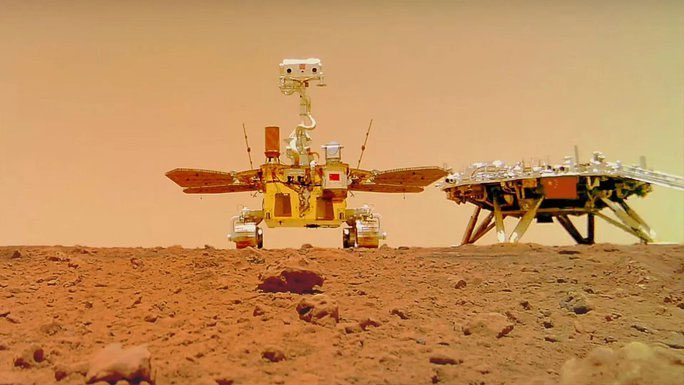China’s Zhurong Mars rover has returned valuable subsurface radar data to Earth, revealing special structures beneath the planet’s surface.
According to Space, data from the ground-penetrating radar of Zhurong (Zhù Róng) indicates evidence of buried impact craters just below the surface of Mars, along with other sloped features of unclear origin.
This imagery stands in stark contrast to the shallow subsurface structures of the Moon previously collected by other Chinese missions. The difference may be attributed to Mars’ thin atmosphere, which acts as a protective layer against micrometeorites and also influences surface weathering.

Selfie image taken by placing Zhurong’s camera on the ground – (Photo: China News Service).
“We found a lot of sand dunes on the surface at the landing site, so it’s possible that these craters were quickly buried by sand. This cover also reduces space weathering, allowing us to see the full shape of the crater walls,” explained Yi Xu, the lead author of the study related to the Zhurong mission.
Zhurong was launched in July 2020 alongside the Tianwen-1 orbital spacecraft and landed in the vast Utopia Planitia region of Mars in May 2021. It is a rover somewhat similar to NASA’s Curiosity and Perseverance rovers.
The landing site was chosen based on technical and scientific criteria, in an area believed to be the shoreline of an ancient ocean. One goal for Zhurong’s ground-penetrating radar, which emits electromagnetic signals from subsurface rocks and collects their reflections, is to search for evidence of trapped water or ice beneath the surface.
Researchers hope that this valuable signal regarding the subsurface world of Mars will provide insights into the planet’s geological development, clues about past climate conditions, and potentially evidence of the presence of water or ice.
The new study has just been published in the Geology journal of the American Geological Society.
Meanwhile, the fate of the Zhurong rover remains unknown. This solar-powered rover entered a dormant state in May 2022 due to the impending winter in Mars’ northern hemisphere. It was expected to automatically resume operations in December, but Chinese space authorities have not commented on Zhurong’s apparent silence since then.


















































